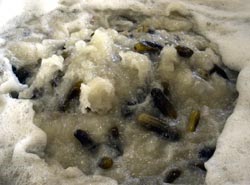
|


Pickling is a global culinary art. If you were to go on an international
food-tasting tour, you’d find pickled foods just about
everywhere. You might sample kosher cucumber pickles in New
York City, chutneys in India, kimchi in Korea, miso pickles
in Japan, salted duck eggs in China, pickled herring in Scandinavia,
corned beef in Ireland, salsas in Mexico, pickled pigs feet
in the southern United States, and much, much more.
What makes a pickle a pickle? On a most general level, pickles
are foods soaked in solutions that help prevent spoilage.
There are two basic categories of pickles. The first type includes
pickles preserved in vinegar, a strong acid in which few bacteria
can survive. Most of the bottled kosher cucumber pickles available
in the supermarket are preserved in vinegar.
The other category includes pickles soaked in a salt brine to
encourages
fermentation
—the
growth of "good" bacteria that make a food less vulnerable
to "bad" spoilage-causing bacteria. Common examples
of fermented pickles include
kimchi
and many cucumber dill pickles.
Pickling is not only an international food-preservation technique,
it’s also an ancient one. For thousands of years, our ancestors
have explored ways to pickle foods, following an instinct to
secure surplus food supplies for long winters, famine, and other
times of need. Historians know, for instance, that over two
thousand years ago, workers building the Great Wall of China
ate sauerkraut, a kind of fermented cabbage.
But pickling foods does much more than simply preserve them.
It can also change their taste and texture in a profusion of
interesting—and yummy—ways. It’s no surprise
that cultures across the globe enjoy such an assortment of pickled
foods, as you would discover on your international food expedition.
In fact, food experts say, the evolution of diverse pickled
foods in different cultures has contributed to unique cultural
food preferences, such as spicy sour tastes in Southeast Asia
and acidic flavors in eastern Europe.

|
|
|

|
